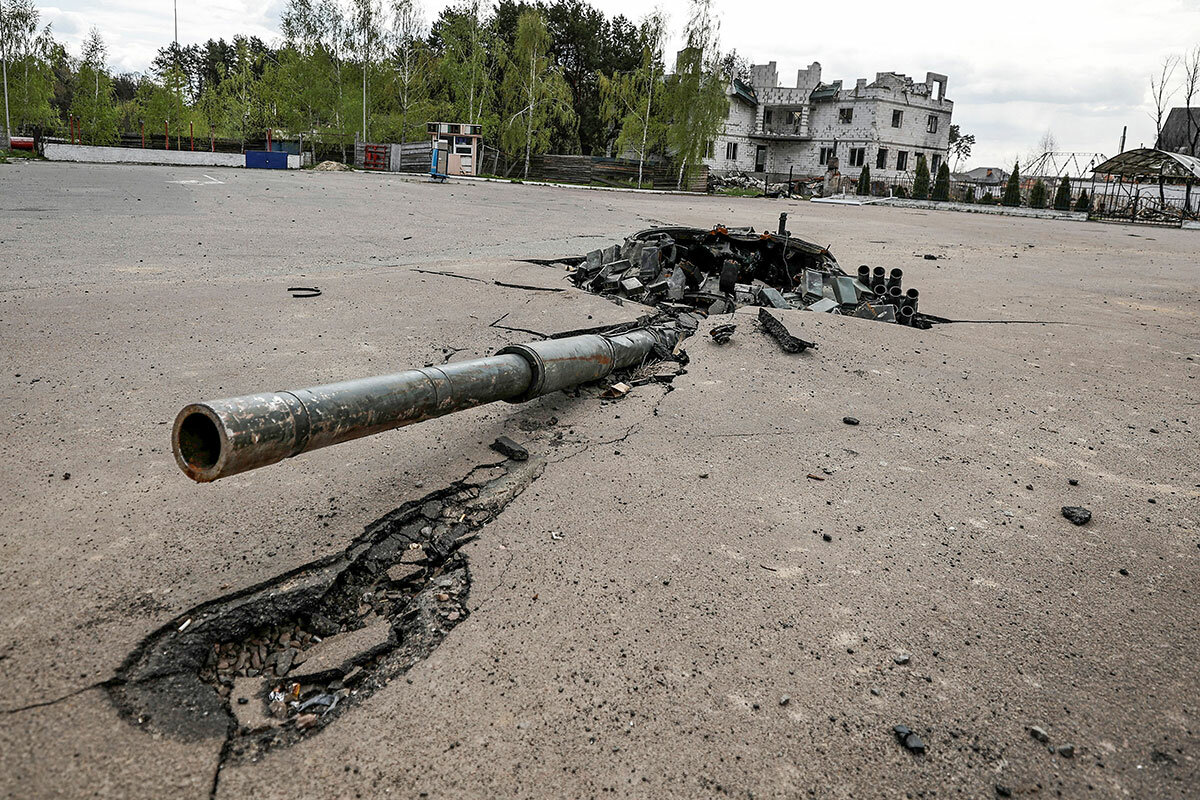On Russia, is US policy edging from defense to offense?
Loading...
| Washington
The Biden administration’s goals for the war in Ukraine appear to be expanding beyond Ukraine.
On a surprise visit to Kyiv last week, Secretary of Defense Lloyd Austin said the United States wants “Russia weakened to the degree it cannot do the kinds of things that it has done in invading Ukraine.”
Even for an administration whose objectives in the conflict haven’t always been entirely clear, the comment was notable. White House officials have so far focused on defending Ukraine from an aggressive neighbor. Now the U.S. seems to be saying it sees an opportunity to ensure that neighbor can’t become aggressive again.
Why We Wrote This
The Biden administration now seems to see an opportunity to weaken Russia – a shift that reflects lessons learned from the conflict so far. But concerns about escalation remain.
Three days after Secretary Austin’s comment, President Joe Biden asked Congress for another $33 billion in aid to Ukraine – more than twice the $13.6 billion approved in March, and two-thirds of which would go to security. The request would transfer heavy weaponry, including missile defense systems and armored vehicles, and is meant to fund Ukraine’s defense for the next five months.
Before February, the administration had resisted this kind of military aid, in part because it didn’t want to provoke the Kremlin. But it’s now spending billions sending Kyiv combat drones, howitzers, stinger missiles, and javelins. How did a White House so concerned with escalation just two months ago pivot to saying it wants to weaken a nuclear rival?
Part of the answer stems from the conflict itself. Russia’s military has not lived up to expectations, and Ukrainian defense has shown high returns on investment. At the same time, the U.S. seems to be taking Russia’s ambitions in the region more seriously.
“This is a significant new pillar of U.S. strategy,” says Lauren Speranza, director of the Transatlantic Defense and Security program at the Center for European Policy Analysis.
“We have realized that we cannot just contain Russia,” she says.
The question for President Biden and his Cabinet is how to harden its response without inciting a wider conflict. But Russia’s leaders are already responding with threats to do just that.
Last week, Foreign Minister Sergey Lavrov said the U.S. was waging a proxy war that could risk nuclear retaliation. Russian President Vladimir Putin warned Western support for Ukraine would draw “lightning fast” consequences.
Those threats may be an indicator of Russia’s battlefield issues. Estimates of Russian casualties range from 15,000 to 22,000, with wounded soldiers likely numbering twice that. After an initial blitz into Ukraine’s east, Russia’s offense is now “plodding,” the Pentagon says.
The Kremlin’s rhetoric is actually a sign that U.S. aid is working and more should follow, says Richard Hooker, a senior fellow at the Atlantic Council.
“At the outset the administration was very concerned about the appearance of direct intervention and was reluctant to provide long-range weapons like aircraft, like long-range artillery,” he says. “In the last week or so, we’ve seen what appears to be a policy shift.”
In just weeks, the Air Force has assembled new types of battlefield drones and trained Ukrainians to use them. After hesitating initially, Washington is sharing live battlefield intelligence with Kyiv. In Germany and two other undisclosed sites, the Florida National Guard is teaching Ukrainians to operate American howitzers.
The administration’s aid request and a lend-lease bill passed by Congress last week are visible commitments to continue that assistance over the long term.
Ukraine likely needs air power to retake territory, and the aid so far doesn’t quite meet the need, says Dr. Hooker. But it’s much closer to the need than the past two administrations reached, after the annexation of Crimea and the start of fighting in the Donbas, he says, and “given that we’re barely two months into this, it’s been a lot.”
Bradley Bowman, senior director of the Center on Military and Political Power at the Foundation for Defense of Democracies, remembers working in the Senate in 2014 when then-Ukrainian President Petro Poroshenko visited Congress. Following the annexation of Crimea, Mr. Poroshenko thanked the U.S. for its humanitarian aid but noted, wryly, that “one cannot win the war with blankets.”
Eight years later, America isn’t just sending blankets. The pace of aid has been “extraordinary,” says Mr. Bowman, with arms reaching Ukrainians just days after being approved in Washington.
Tens of thousands of Russian soldiers are still in Ukraine, fighting a deadly war of attrition and razing entire cities. And Mr. Putin may escalate regardless of what happens, given the stakes for his hold on power.
“They’re still there,” says Morgan Viña, a fellow at George Mason University’s National Security Institute. “That’s important to note – that Russia is still persisting with this war.”
Recent explosions in Transnistria, a disputed region of Moldova, may also indicate that the war is starting to widen. Mr. Putin has refocused his efforts on eastern Ukraine, but that doesn’t mean he won’t expand it later, says Richard Haass, president of the Council on Foreign Relations.
Harsh economic and military costs mean Russia will already exit this war weaker, he says. “I don’t believe that explicitly calling for weakening Russia as a goal is a wise idea,” says Dr. Haass, who was director of policy planning for the Department of State from 2001 to 2003. “It reinforces Putin’s message that this is really not about Ukraine.”
Ms. Viña also would prefer U.S. policy to focus on a free Ukraine, with Russian weakness as a byproduct. Secretary Austin’s newly formed Ukraine Contact Group is a good example of how to achieve that, she says. The body of 40 U.S. allies has pledged to meet each month and coordinate aid to Ukraine. Germany, one of its members, has already pledged up to 50 armored vehicles.
Getting the balance right is difficult, though. Ukraine has a tight window to protect itself against a much larger adversary, and Russia is sure to perceive all foreign aid as provocative. Dr. Hooker, who served in the National Security Council under multiple administrations, knows how difficult weighing those goals can be. Russia’s threats need to be taken seriously, he says, but if it isn’t stopped in Ukraine, when will it be?
“We have an opportunity to end this threat for a generation, if not forever,” says Dr. Hooker. “If we don’t, we’re going to find ourselves watching the same movie all over again in a few years.”







